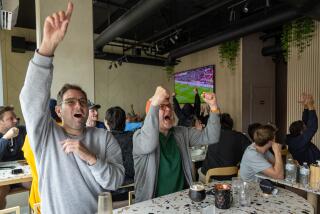January file
SEEN / Cue Tip
Forget nine ball. It’s time you’ve discovered snooker--just hope you don’t run into the U.S. champ, who lives in L.A. By Matthew DeBordAsk for a game of snooker in any local pool hall, and you’ll probably be met with blank stares. Eight ball, of course. Nine ball, sure. Those are the old standards in the North American lexicon of rack ‘em and break ‘em--integral parts of a legacy that spans Paul Newman in “The Hustler” to the legend of Minnesota Fats.
Snooker, on the other hand, is a whole other ball game. Although it’s popular in England--British snooker champions Ronnie O’Sullivan and Jimmy White compete in major venues with cheering crowds--finding a place to play snooker in L.A. isn’t easy. But it turns out that the heart and soul of U.S. snooker is, surprisingly, in the San Gabriel Valley. Specifically, Embassy Billiards on San Gabriel Boulevard, which is the headquarters of the U.S. Snooker Assn. and home court of the last three national champions: George Lai (‘05), Paul Kimura (‘06) and current titleholder Jack Kung.
The expatriate Hong Kong community dominates the snooker scene here, although an Englishman will occasionally make an appearance. At members-only Embassy Billiards (one year is $25; lifetime is $50), most of the players who book the hall’s 12 snooker tables on busy Friday and Saturday nights are of Asian descent. The tables themselves, though manufactured in England, have all been shipped in--from Hong Kong. The Embassy’s late founder, David Yao, was a World Amateur Snooker champion--from Hong Kong.
Located on a street where there are more signs in Chinese than in English, Embassy--part of a nondescript building that also includes a restaurant--is a vast departure from snooker’s roots. The game was invented in British colonial army garrisons in the 19th century and later migrated to pubs and gentlemen’s clubs. At Embassy, however, there is no polished wainscotting, and there are certainly no Persian carpets. In fact, with the exception of some couches and a big-screen TV, the dim room is mostly about serious playing (evidenced by the proudly displayed row of snooker trophies). On the floor, each table is individually lighted. Competitors can be seen lingering in these halos, cagily studying each other’s shots, as snooker involves careful observation and planning.
The game is played on a much larger table than pool and with smaller balls, but the main difference is mental. “Snooker requires more thinking,” says Embassy manager Benny Yiu. The key is strategic positioning, because every shot must flow into the next. The goal is to “pot,” or pocket, the balls in a specific order. You score points for each potted ball until there are no balls left on the table, and the player with the most points at the end wins. A score of 100 or higher is called a century break, considered a hallmark in a player’s development.
But that’s nothing compared with the elusive maximum break, a rare and exhilarating expression of concentration and expertise that occurs when a player runs the table, potting the balls in methodical sequence, without interruption on the way to a score of 147. (Examples of famous maximum breaks can be viewed on YouTube.)
Although some professionals play at a brisk pace, snooker is generally a leisurely game. A single frame can consume more than an hour, as competitors trade makes and misses. It’s essential, however, to pay close attention to the veritable chess match that’s unfolding on the table. An opponent’s miss can turn into an instant winning opportunity--as long as you’ve been scrupulously monitoring the layout of balls. However, you never want to let your opponent catch you thinking ahead; it’s the billiards equivalent of poker: You want to wear an affectless snooker face while constantly working out the geometry of your chances.
More key differences between pool and snooker? For one, the cue. A pool cue is often heavier with a larger tip, while a snooker cue has a smaller tip that allows players to put considerable spin on the cue ball. And most snooker players are aggressive chalkers, reapplying chalk after each shot. Also, although the mode of dress at Embassy is California casual, professionals such as Kung usually compete in a uniform of sorts: a black snooker vest.
Practice, of course, is essential. Yiu gave up the game because he couldn’t live up to its demands: “I was frustrated. I couldn’t improve anymore.”
But for many other players, snooker’s mental challenges make it all the more addictive. “There are some guys who come in here every day,” Yiu says. “I’m not sure what else they do.”
--
Fare game
Taking Off: Flights of Fancy
It used to be that flights involved airplanes. But now that wine has taken root in culture, hot-spot eateries are appropriating the “flight” concept for all manner of non-oenophilic fare (traditionally, a flight is a lineup of wines to be tasted). From the petite portions of chocolate textures at Royale near MacArthur Park, to the salsa flight sampler at Malo in Silver Lake, the idea is landing on menus across town. “It’s just a fun way to let customers experience the whole palette of flavors,” says Malo manager Matthew Dickson.
--
Aroung Town This Month
Investigate some inspiring oratory. In the spirit of Martin Luther King Jr. Day, check out a modern take on Sunday prayer services at Culver City’s “transdenominational” Agape spiritual center, blending meditation with traditional sermons.--michael shawproduct development
--
Wear Your Resolve
66% of American adults are overweight
53% make New Year’s resolutions to shed pounds or eat healthier
30% flake by the time February rolls around
80% get off track within six months*
$20 is how much you’ll pay for a FoodTee, the wittiest way to remind yourself to stay on the wagon. Cotton T-shirts are printed with clever phrases that promote healthy eating, such as “all natural” (pictured with a plump raspberry), “flower child” (a cauliflower head) and “stalker” (a stalk of celery). Plus, a portion of the proceeds goes toward programs for school nutrition. www.foodtee.com
*Statistics from National Center for Health Statistics, eDiets.com and Wall Street Journal Online/Harris Interactive
--
Things You Need to Know About Snooker
THE STANCE
The proper snooker stance is slightly different from the typical pool stance. In pool, the stance is at an angle to the shot. In snooker, players stand more square.
THE TABLE
The standard snooker table is larger than the familiar pool table. Red balls are racked using a triangle, while colored balls are positioned in specified spots around the table. Unlike pool, breaks tend to be gentle.
THE POINTS
The balls each have a distinct point value. There are 15 red balls, six other balls in various colors, and, of course, a cue ball.
More to Read
Go beyond the scoreboard
Get the latest on L.A.'s teams in the daily Sports Report newsletter.
You may occasionally receive promotional content from the Los Angeles Times.










